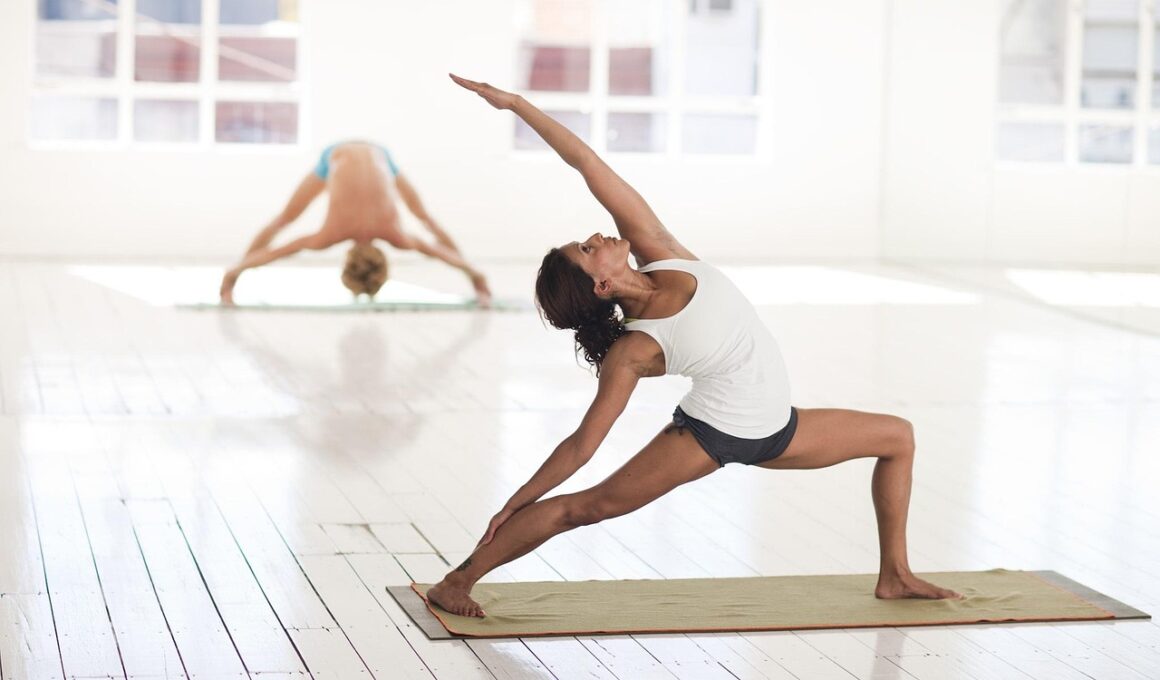Isometric Stretching: How It Helps Enhance Flexibility
Isometric stretching is a technique that involves contracting a muscle while it is in a stretched position. This method effectively enhances flexibility because it helps to increase the range of motion in a joint. When performed properly, it can lead to improved athletic performance, as muscles become better conditioned. Unlike dynamic or ballistic stretching, which involves movement and bouncing, isometric stretching focuses on maintaining a steady position. This stability can contribute to better muscle control and can also be beneficial for rehabilitation purposes. It is essential for individuals looking to increase their flexibility safely. Additionally, isometric stretching can help to improve muscle symmetry, which can be crucial for athletes seeking a balanced performance across various sports. Engaging in these stretches on a regular basis can lead to long-term flexibility gains, making it a valuable addition to any fitness regime. As with any exercise technique, it is important to listen to your body and avoid pushing past your limits to prevent injury. When incorporated correctly, isometric stretching can enhance physical fitness significantly and support overall well-being.
The Science Behind Isometric Stretching
The scientific rationale for isometric stretching stems from its impact on muscle fibers and connective tissues. By contracting the muscle while stretching, you trigger a physiological response that may promote muscle elongation over time. This method activates the Golgi tendon organs, which essentially help to inhibit the muscle contraction, ultimately allowing it to relax further. In this way, it can significantly contribute to flexibility improvement. This stretching approach can also improve the elasticity of tendons and ligaments. Research in sports science indicates that integrating isometric stretching with conventional training can enhance performance outcomes. Furthermore, this technique can help in reducing muscle soreness and improving recovery times after intense workouts. By enhancing the overall muscle health, individuals can expect to achieve not only better performance but also a lower probability of injury. Athletes who are dedicated to their training often find that understanding these underlying mechanisms helps them appreciate the value of isometric stretching. Regular practice promotes muscle resilience, yielding better results in strength training and athletic achievements, which benefits enthusiasts and professional athletes alike.
One of the significant advantages of isometric stretching is its versatility as it can be performed anywhere without special equipment. This flexibility makes it an excellent option for those with busy schedules or limited access to gyms. You can execute isometric stretches during breaks at work, during your home workout, or even while watching television. Furthermore, it is highly adaptable to suit various fitness levels and can cater to both beginners and advanced athletes alike. Whether you are an experienced athlete aiming to improve performance or a beginner looking to enhance flexibility gradually, this technique can be utilized effectively. To incorporate isometric stretching into your routine, ensure that you focus on major muscle groups that need enhanced flexibility. It’s also advisable to follow a proper warm-up to prepare your muscles for stretching. Always remember to hold each position for a minimum of 15 to 30 seconds, and breathe deeply. The combination of breath control and sustained muscle contraction enhances the effectiveness of each stretch, allowing for greater flexibility gains over time. By integrating these stretches consistently, individuals can enjoy improved mobility and overall performance.
How to Perform Isometric Stretching Safely
To achieve the best results from isometric stretching, it is crucial to understand the correct techniques and safety precautions. First, identify the target muscles and position your body correctly to avoid strain. Start with gentle stretches to warm up the muscles and prepare them for the isometric hold. Ensure you maintain a comfortable and steady position while contracting the muscle. It is vital not to bounce or force the stretch, as this can lead to injury. Instead, focus on holding the position in a controlled manner for 15 to 30 seconds at a time. After each stretch, release the contraction and relax the muscle for a brief moment before repeating. Gradually increase the duration as your flexibility improves. Moreover, ensure a balanced training approach by including various stretching methods to complement your progress. Lastly, listen to your body’s signals; if you feel pain or discomfort, stop immediately and allow for recovery. Consulting with a physical therapist or fitness expert can provide further guidance tailored to your specific needs and conditions. This way, you can maximize the benefits while minimizing the risks associated with stretching.
If you are considering isometric stretching as part of your flexibility training, it may be beneficial to pair this technique with other types of stretching. Combing dynamic stretches, static stretching, and isometric holds enhances overall muscle elasticity. Many athletes find that integrating various techniques into their training program not only improves flexibility but also promotes better strength and coordination. The combination can create a well-rounded routine that caters to all fitness aspects. When framing your overall stretching strategy, consider your specific goals and the time you can devote to training. Establishing a routine that includes at least two to three sessions each week will promote meaningful progress towards flexibility enhancement. Also, be aware that isometric stretches can be applied to specific sports activities, such as gymnastics, martial arts, and dance, where flexibility plays a crucial role in performance. It may be helpful to consult fitness professionals who can design personalized plans focusing on key areas that require improvement. With consistent effort and the right approach, the results of an isometric stretching regimen can lead to significant improvements in flexibility, overall performance, and injury prevention.
Common Mistakes to Avoid with Isometric Stretching
While practicing isometric stretching can be immensely beneficial, some common mistakes can hinder progress or lead to potential injuries. One prevalent mistake is not properly warming up before engaging in isometric stretches. Warm-up exercises get the blood flowing to your muscles, which helps prevent strains. Additionally, holding stretches for too long before achieving optimal muscle tension can reduce effectiveness. Instead, aim for the balance of muscle contraction and relaxation, holding stretches for an appropriate timeframe. Another common error is overstretching or pushing yourself too hard, which can result in injury rather than improvement. It is essential to appreciate your current flexibility level and build from there. Failing to listen to your body can lead to burnout or missed workouts. Ensure to alternate isometric stretches with rest days to give your muscles time to recover and adapt. Lastly, practicing without proper guidance can allow bad habits to develop over time. Consider connecting with an experienced trainer or joining a class focused on flexibility techniques. By remaining mindful of these common pitfalls, practitioners can more effectively harness the benefits of isometric stretching.
Incorporating isometric stretching into your fitness regimen offers numerous benefits. Effectively performed, it enhances flexibility, reduces the risk of injury, and supports athletic performance. To ensure that you remain motivated, tracking your progress can be helpful. Consider keeping a journal documenting your flexibility goals and achievements. By noting improvements over weeks or months, you may find renewed motivation to continue your practice consistently. Establishing a routine while enjoying the variety throughout can transform your approach to stretching. Engaging with a community or finding a workout partner can introduce fun and accountability, ultimately leading to improved results. As you stay mindful of your technique and include isometric stretching in your overall plan, you will undoubtedly notice positive changes in your flexibility over time. Therefore, remain committed to your practice and always celebrate your accomplishments, big or small. Remember, achieving improved flexibility is a journey that takes patience, dedication, and discipline. With proper implementation, isometric stretching can become a cornerstone of your fitness regimen that supports all related activities. Through increased flexibility, your body will feel more energized and capable of handling daily challenges with ease.


